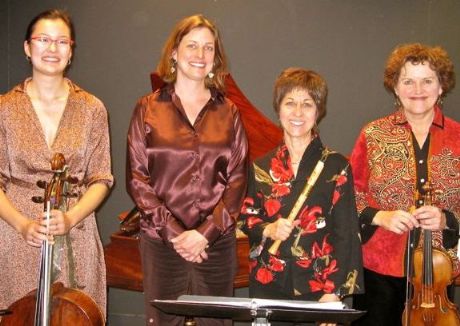|
Symphony
FROM THE NEW WORLD TO THE OLD WORLD
by Peter Lert
Saturday, June 14, 2025
Chamber
MC2 DUO RECITAL CLOSES 222'S SEASON
by Terry McNeill
Saturday, June 14, 2025
Choral and Vocal
CANTIAMO SONOMA'S LUSCIOUS A CAPELLA SINGING IN SEASON ENDING CONCERT
by Pamela Hicks Gailey
Sunday, June 8, 2025
Symphony
SRS SEASON ENDS WITH RESOUNDING TA-TA-TA-BANG
by Terry McNeill
Sunday, June 1, 2025
Symphony
YOUTHFUL VIRTUOSITY ON DISPLAY AT USO'S MAY CONCERTS
by Peter Lert
Saturday, May 17, 2025
Symphony
MYSTICAL PLANETS AND LIVELY GERSHWIN ORTIZ AT FINAL SRS CONCERT
by Peter Lert
Sunday, May 4, 2025
Symphony
VSO'S CONCERT MUSIC OF TIME, MUSIC OF PLACE
by Peter Lert
Sunday, April 27, 2025
VOCAL ELEGANCE AND FIRE AT THE 222'S RECITAL APRIL 26
by Pamela Hicks Gailey
Saturday, April 26, 2025
CANTIAMO SONOMA SINGS AN INSPIRED GOOD FRIDAY MOZART REQUIEM CONCERT
by Pamela Hicks Gailey
Friday, April 18, 2025
DRAMATIC SHOSTAKOVICH SYMPHONY CLOSES PHILHARMONIC'S 25TH SEASON
by Terry McNeill
Sunday, April 13, 2025
|
 |
 Musica Pacific in Petaluma (l to r) Hunt, Heater, Linsenberg, Blumenstock |
MUSICA PACIFICA'S BURNISHED VIRTUOSITY IN PETALUMA ITALIAN BAROQUE CONCERT
by Joanna Bramel Young
Friday, January 13, 2012
Early music specialists Musica Pacifica played a concert Jan. 13 in the Petaluma Historical Museum that featured virtuoso Italian music from the 17th Century. The Museum is the stately columned old Carnegie Library and has a high ceiling, providing fine acoustics. The small audience was gathered closely around the performers, allowing for a special intimacy.
Members of the group were recorder player Judith Linsenberg, violinist Elizabeth Blumenstock, cellist Shirley Hunt and Katherine Heater, harpsichord. Ms. Linsenberg is a star in the world of recorder virtuosi, known for her careful study of the programmed music and the brilliance of her instrumental technique. Playing two different soprano recorders, replicas of 17th century instruments, she was able to negotiate the most daunting allegros with ease, and emotions changed at a moment’s notice from pyrotechnical brilliance to passionate longing. The ensemble stayed with her through every measure. Alto and tenor recorders were used in some of the pieces, but in this concert the soprano was king.
Opening the program was the Sonata Duodecima of Dario Castello, a short work but offering a tapestry of changing emotions. The recorder and violin played off each other in improvisational echo passages. Each section, which in later years would have been separate movements, blended effortlessly into the next, with emotions swiftly changing on the way.
Maurizio Cazzeti’s Capriccio sopra sette note was a set of variations over a ground bass, the latter creating a firm, energetic foundation over which the two solo instruments (recorder and violin) showed off their virtuosity.
Singer and organist Girolamo Frescobaldi was perhaps the most distinguished musician of the 16th Century, and when he was appointed organist at St. Peter’s in Rome his first performance was said to have attracted 30,000 listeners. Ms. Heater played Frescobaldi’s Toccata Undecima on her Italian-style harpsichord, every note in the large room clear and vivid. The Italian word “tocare” means to touch, and this work combined free-form sections with more imitative sections, demonstrating the versatility of touch and articulation that the harpsichord does so well. Ms. Heater performed the extreme harmonic modulations and elaborate cadential ornaments with great attention to nuance.
Before intermission the ensemble played Sonata a tre “Il Corisino” of Francesco Turini, surely one of the concert’s high points. According to the program notes this piece used a popular tune of the day over variations, and the tune was indeed a haunting, lyrical melody. The Variations were carried by the violin and recorder and fingers were flying!
In the second half Ms. Hunt played an unaccompanied Recercata settima by G. B. degli Antonii that brought out the improvisatory aspects of the piece, her cello bringing out the free form quality of the Recercata.
Besides the many short sonatas Musica Pacifica added charming dance pieces – Balleto, Aria, Corrente, Giga and Allemanda – by various composers. The Sonata Quarta of Biagio Marini was scored for harpsichord and violin, and Ms. Blumenstock played superbly with a Guarneri instrument made in 1660. She commented to the listeners that the violin might very well have played this music centuries ago. Her style is sensitive and expressive, the vocal nature of the writing requiring great contrasts and elaborate descending runs and double stops. Parts of the work remind one of the “Winter” concerto from Vivaldi’s Four Seasons with the colorful evocation of a driving storm. The harpsichord balanced the violin perfectly, bringing out the melody and letting Ms. Blumenstock to play the embellishments.
The program concluded with an animated Ciaccona by Andrea Falconieri. A ciaccona is a dance that consists of a repeated bass line over which the treble instruments play a series of slow and fast variations. This Ciaccona began with a solo harpsichord, with the cello, recorder and violin subsequently entering. Approaching the conclusion all were playing at breakneck speed when the piece suddenly ended, the four instruments silent at the same moment. The audience was transfixed.
|

